Despite our sunny climate and predictable winters, there are often restrictions on what we can grow in Australia. European natives, and many Northern hemisphere plants from cooler, more temperate continents are often too fussy, or not drought tolerant enough to be practical garden plants for most gardens. But… the most iconically European of them all, Buxus sempervirens, loves it here.
From formal Italian parterres to twee Tudor knot gardens and quaint French potagers, Buxus sempervirens might not be groundbreaking, but it sure is satisfying. Learning to plant, care for and shape your own European box hedge is an essential gardening skill, and one that will completely transform your outdoor space.
More...
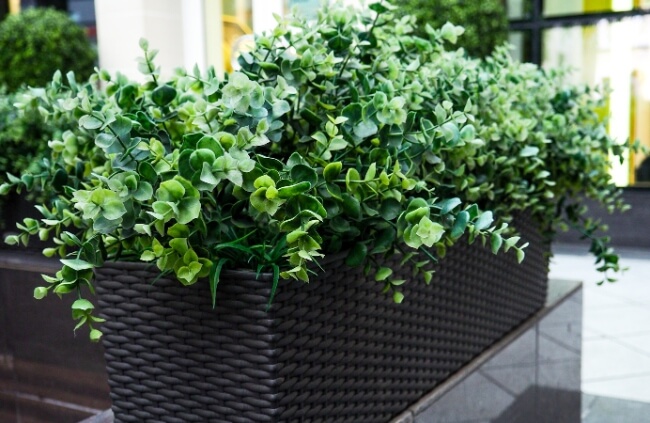
Genus: | Buxus |
|---|---|
Species: | sempervirens |
Family: | |
Origin: | Western and Southern Europe and Northern Africa |
Common Names: | Common box, English box, European box, Boxwood, Box |
Location: | Outdoor |
Type: | Evergreen shrub |
Growth: | Up to 9m tall |
Sun requirements: | Part shade to full sun |
Foliage Colour: | Dark green |
Flower Colour: | Cream / white |
Flowering: | Late spring |
Edible Parts: | None |
Maintenance level: | Medium |
Poisonous for pets: | All parts are toxic, but rarely ingested |
What is Buxus sempervirens?
While the vast majority of box hedges you will see around Australia are 2-3ft tall, and shaped into neat, rectangular forms, the plant itself can reach up to 9m tall and tower over its rivals with loose spindly stems – making a gorgeous tree in its native woodlands.
However, thanks to its ability to grow from old wood and retain foliage through all seasons whatever the weather, this classic English box is most commonly used as a formal hedging plant.
The neatly rounded foliage of Buxus sempervirens can display yellows through to green depending on specific cultivars, and each cultivar will often change its colour slightly through the seasons as well.
If left to flower, English box can be covered in discreet white blooms in spring.
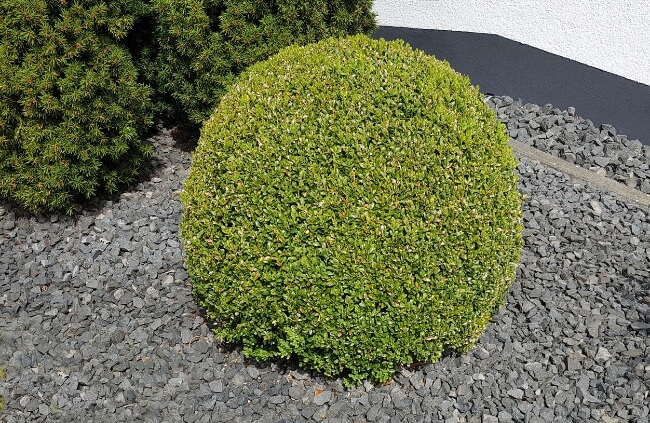
Natural Habitat of Buxus sempervirens
Buxus sempervirens is native to the European and Asian landmass, with some also found in the Northern tip of Africa. In all cases, it requires relatively cool, moist summers to thrive as it is only slightly drought tolerant (meaning it will require regular watering in most parts of Australia).
In its natural habitats, English box grows as both a woodland edge plant, and out in open landscapes, with some found growing in coastal areas, where it copes surprisingly well with strong salty winds.
Common Uses for Buxus sempervirens
In garden settings, Buxus sempervirens, also called box or boxwood, are grown as a formal plant. That can mean a few different things though.
Firstly, hedging is the most regular use for Buxus not just in Australia but around the world. Next, we’ve got topiary. Topiary is the art of shaping and maintaining formal forms in evergreen shrubs.
As well as Buxus, yew, some Lonicera species, and the larger-leaved privet can be used to create tightly clipped shapes in wild and creative ways.
And finally, the simplest and most effective way to use common box is as punctuation. Box balls, as we call them, are incredibly easy to create from young plants, and can be planted in containers, or directly into garden soil. They take up less space than hedges, but provide evergreen structure and punctuation points for looser planting throughout any garden.
Buxus sempervirens Cultivars for Australian Gardens
As well as the naturally occurring Buxus sempervirens, there are a handful of reliable cultivars – meaning manmade, varieties that have been bred to produce certain traits within that species.
None are resistant to box blight, but there are some alternatives like Better Buxus Heritage with similar traits and which claim to be resistant to box blight.
As for the visually different box hedges, have a think about some of these to bring a sense of identity to your garden:
Buxus sempervirens ‘Latifolia Maculata’ Also called Buxus ‘Japonica Aurea’, this gorgeously variegated cultivar offers fleshy, deep green foliage, with a golden variegation of yellow flashes on young leaves. In spring, there is a real joy to be had from this spectacular cultivar, which we use as structural box balls in our back garden, amongst taller, fluffier planting like thalictrum and plume poppy. | 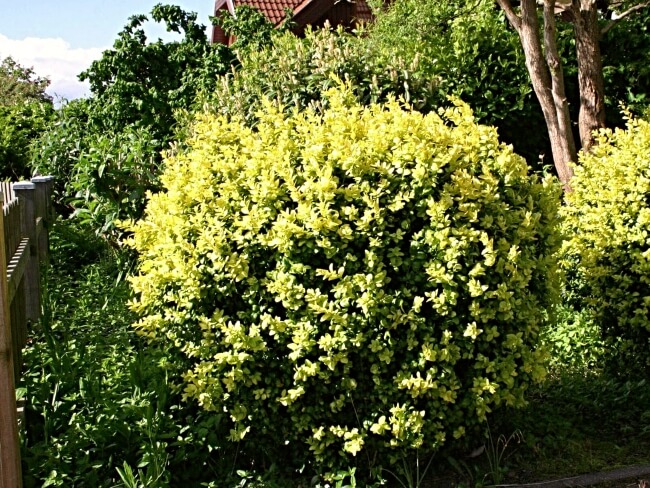 |
Buxus sempervirens ‘Rotundifolia’ Buxus ‘rotundifolia’ is a standard choice for formal gardens. While it has little disease resistance, it does offer something quite special – consistency. At every time of year, the same matt green tone sings out from the larger-than-normal leaves, offering reliable greenery all year round, which can make planning more vibrant planting much easier. | 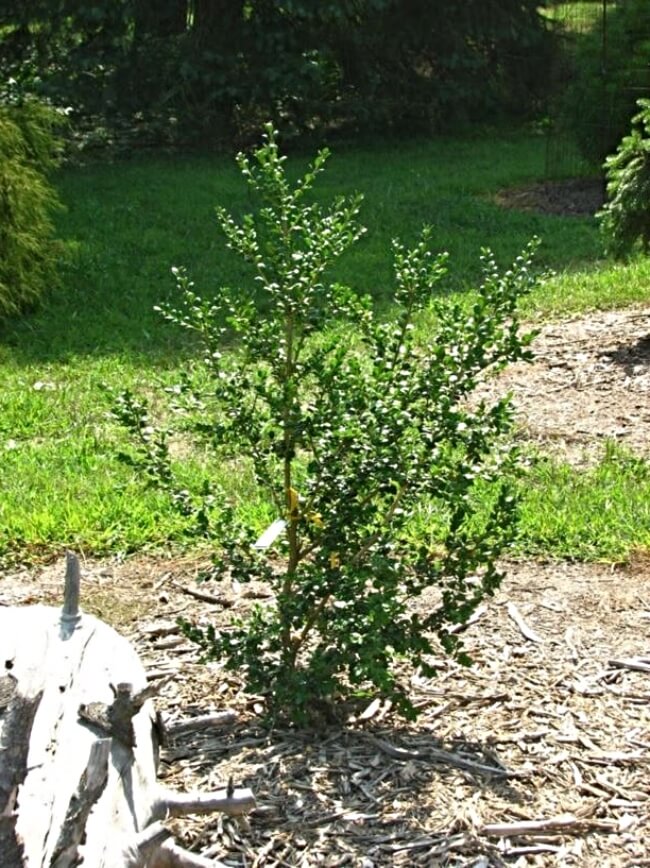 Source: Dawes Arboretum Explorer |
Buxus sempervirens ‘Blauer Heinz’ Translated to ‘Blue Henry’ in English, Buxus ‘Blauer Heinz’ has a faintly blue tint to its leaves, but otherwise grows to a similar height to its naturally occurring parent. However, denser foliage makes it ideal for regular pruning. |  Source: Plantsbenefits |
Buxus sempervirens ‘Suffruticosa’ Box hedging does require a lot of maintenance if you want a low hedge – something that visually defines many French potagers. But, if you’d rather keep maintenance to a minimum, but still want that same look, Buxus ‘Suffruticosa’ is a useful dwarf cultivar. |  Source: Dawes Arboretum Explorer |
Buxus sempervirens ‘Elegantissima’ While ‘Latifolia Maculata’ might have the plaudits, the most impressive variegation tends to come from Buxus ‘Elegantissima’, with silvery variegations that hold strong across new and semi-mature foliage, creating a much more even shimmer across the entire plant. |  Source: Ryeland Gardens |
Buxus sempervirens ‘Latifolia Maculata’

Also called Buxus ‘Japonica Aurea’, this gorgeously variegated cultivar offers fleshy, deep green foliage, with a golden variegation of yellow flashes on young leaves.
In spring, there is a real joy to be had from this spectacular cultivar, which we use as structural box balls in our back garden, amongst taller, fluffier planting like thalictrum and plume poppy.
Buxus sempervirens ‘Rotundifolia’

Source: Dawes Arboretum Explorer
Buxus ‘rotundifolia’ is a standard choice for formal gardens. While it has little disease resistance, it does offer something quite special – consistency. At every time of year, the same matt green tone sings out from the larger-than-normal leaves, offering reliable greenery all year round, which can make planning more vibrant planting much easier.
Buxus sempervirens ‘Blauer Heinz’

Source: Plantsbenefits
Translated to ‘Blue Henry’ in English, Buxus ‘Blauer Heinz’ has a faintly blue tint to its leaves, but otherwise grows to a similar height to its naturally occurring parent. However, denser foliage makes it ideal for regular pruning.
Buxus sempervirens ‘Suffruticosa’

Source: Dawes Arboretum Explorer
Box hedging does require a lot of maintenance if you want a low hedge – something that visually defines many French potagers. But, if you’d rather keep maintenance to a minimum, but still want that same look, Buxus ‘Suffruticosa’ is a useful dwarf cultivar.
Buxus sempervirens ‘Elegantissima’
While ‘Latifolia Maculata’ might have the plaudits, the most impressive variegation tends to come from Buxus ‘Elegantissima’, with silvery variegations that hold strong across new and semi-mature foliage, creating a much more even shimmer across the entire plant.
How to Grow Buxus sempervirens
Buxus isn’t particularly fussy about soil type or sunlight but it hates having wet feet, and it won’t enjoy drought either. If you prepare your soil well and take care of box hedging while it establishes, you’ll have a fairly easy-going but utterly gorgeous structure for years and years to come.
Our guide below shares general tips as well as some specific instructions on how to grow and care for common box at home, so you get the best results quickly, and can make them last.

The Best Conditions for Growing Buxus sempervirens
Soil & Drainage
The basic rule for good soil is to avoid bogs and sand. Anything in between will be just fine, provided you treat them accordingly. Buxus isn’t picky about acid or alkaline soils, but the neutral or slightly acidic soil is ideal, and a good mulch of coniferous bark every few years will help to maintain that pH, as well as retain moisture through summer.
Light & Temperature
English box is native to cool, temperate climates. Australian summers can be harsh for them but are rarely fatal. In extremely warm weather, they may lose leaves as a natural defence mechanism, but they can regenerate once watered.
In terms of light, you will find that the side of your Buxus with the most direct sun exposure will generally be greener, and lusher. The shaded side often develops hollow patches. This isn’t anything to worry about, but clever pruning around the holes can often encourage bushier growth to fill them out.
Buxus grown in part shade can be pale but will grow just as well, and often require less frequent watering through summer.
Shelter
As they establish, this Buxus species will not require shelter, but they do benefit from staking, or a wire support against strong winds. Mature plants are incredibly resilient to high winds and make a great wind break in themselves. Just remember to offer some support against extreme winds for young box plants while they establish if your garden is particularly exposed.
Planting & Spacing
Box will root from stems that touch the ground, and can send up volunteers from its root ball, so is naturally adapted to growing in close proximity to rival plants of its own species, and sharing nutrients.
That means that spacing isn’t actually that crucial, and they will usually compete well, and fill out faster when planted closer together than most typical advice.
The usual guidance for planting young box plants, regardless of the type or species, is to plant about 40cm apart, but we find that planting 25-30cm apart is a good way to establish a thicker hedge faster.
For topiary or box balls, Buxus sempervirens always look best with a single stem (grown as a ‘standard’). While it will take longer to fill out, it will look much neater, and far more symmetrical once you reach your final form.

Bare Root Vs Potted Buxus Plants
If you have a long stretch of boundary to fill out, potted, semi-mature Buxus can be an expensive way to do it, but it is risk-free, and will nearly always provide some sort of formal structure within a couple of years.
However, if you’re looking to save money, and willing to take a slight risk, you can in fact get bare-root Buxus sempervirens from most larger shrub nurseries. These are a little more complicated, but much, much cheaper alternatives.
Bare root shrubs are quick to establish but need much more care for their first few months, and should always be planted in winter or very early spring, unlike plants sold in pots, which can be planted at any time of year.
Note: If you do opt for bare-root Buxus sempervirens, make sure they are placed in a bucket of clean water as soon as they are delivered, and planted as soon as possible. These plants are removed from the earth, wrapped (usually in plastic) and delivered as quickly as possible at the right time of year. The longer you hold off with planting, the more likely they will fail.
Growing English Box in Pots
Buxus sempervirens will grow happily in pots, provided they are given good drainage at the base of the pot, and a loamy compost for the majority of the container. Around the base of the plant, as a surface layer, add grit or shredded bark as a decorative mulch, which will also stop damp soil from splashing the lower leaves of your shrubs.
This is an effective barrier against fungal problems that can be quite common in potted common box.
How to Propagate Buxus sempervirens
Taking cuttings from Buxus sempervirens is actually pretty simple. You’ll need a few things to get started, but once you’ve done the first one, you’ll have plenty of home-grown box plants in no time at all.
Note: If you can encourage your own Buxus sempervirens to flower, and successfully bear seed, then you can collect that, and you can propagate it, but the process just isn’t worth it. Instead, focus on taking cuttings from the material you are pruning anyway.
You’ll need horticultural grit or perlite to make sure the soil drains well, and a simple store-bought cutting compost to provide the growing medium.
Buxus cuttings taken at the right time of year are quick to root, so rooting gel isn’t necessary, but it is helpful. Read our guide here for more information on rooting gel vs rooting powder.
Step-by-step guide for Buxus sempervirens cuttings:
- Fill a small plastic pot with cutting compost and a decent handful of grit or perlite.
- Tamp the pot down against the table to remove air pockets.
- Take 10-15cm cuttings from young English box shoots in spring, by cutting just above a node (this helps the plant to keep a tidy form).
- Quickly trim the cutting so the base cut is now just below the lowest node (this means the bottom cut is packed with natural rooting hormones).
- Dip the cut point in rooting gel or powder to boost its chances.
- Insert cuttings into their pots (four per pot is usually about right).
- Water them well, and cover them with a plastic bag to retain moisture.
- Check them after about a month for signs of root development.
- After a couple more weeks there should be signs of foliage developing.
- At this point, tease out each cutting and plant it in an individual pot, then place it somewhere bright and keep the soil moist until it’s ready to plant out or pot on.
Caring for European Box
Mulching Buxus sempervirens
Mulching Buxus plants to retain moisture throughout summer is important in Australia. A healthy layer of at least 2 inches is required for adequate moisture retention, both to reduce watering and minimise evaporation through hot summers.
Mulching in spring is ideal, but it doesn’t need to be an annual affair. Applying a thick bark mulch around the base of Buxus sempervirens every three years is more than adequate.
I prefer to use confider bark as a mulch as they refer to slightly acidic soils to slightly alkaline, or neutral, and as the bark mulch breaks down it helps to open up soil structures too. The result is a better habitat for Buxus roots and a more moisture-retentive soil all around. Plus, conifer bark is a great budget mulch.

Pruning English Box
Pruning common box is, more than likely, the main reason you’re here. But really, there’s not that much to say. As long as you clean your tools you can’t actually do that much damage to box.
It’s a resilient plant that grows from old wood, and will generally recover from a bad prune. The best advice we can give is to give it a go, and not get too upset if it goes wrong.
But there are some tips that make pruning Buxus sempervirens easier, and we’ve also tidied up some techniques that hopefully offer guidance on the styles that can get the most out of these simple but sumptuous plants.
Tools for Pruning Buxus
Before getting started on actual pruning, consider the size, shape and maturity of the plants and branches you’re pruning. This will have an impact on what tools you use, and how you use them.
If you’re unsure about any of the suggestions below, we’ve written complete guides to each, including links to some of the best brands online. Just follow the links below.
- Secateurs are generally used for precise pruning of plants like roses that have thick stems but need regular deadheading, but they are ideal for delicate topiary shapes, or pruning more considered branches if you need to thicken out certain parts of your shrubs.
- Hedge shears are the fastest way to shape Buxus plants without using power tools, but there is a certain skill to using them well. Always cut to the general shape first, and take a step back occasionally to get the best possible finish.
- Topiary shears are smaller than hedge shears and are designed for quickly and regularly cutting back the fresh growing tips to maintain a formal shape all year round. If you’re trying to find a balance between pruning and wildlife, they also limit your pruning to the very tips of plants, meaning you won’t disturb nesting birds in taller hedges.
- Loppers are only really for major pruning. They have more powerful jaws and can usually cut branches up to about 2” thick. If you have to cut out sections of diseased growth or want to radically change the shape of your box hedging, then loppers are the best option.
- Electric hedge trimmers and Petrol hedge trimmers are great for taller hedges, and some even come with extendable poles to get neater, straighter finishes above head height. In most cases, electric hedge trimmers are sufficient, but you might want to consider petrol trimmers for longer hedges where wires or short battery life can negatively impact electric models.
Common Pruning Methods for English box
Topiary kind of covers everything below, but in the strictest terms, it refers to more creative forms of hedge trimming, whether that’s abstract shapes or more recognisable forms like animals or chess pieces (some of the more common traditional topiary structures).
Buxus is a really tough plant, and its tendency to grow up to 9m tall means it can even be used to create living tunnels, where the inside of the mature tunnel is a maze of twisting twigs, while the outside is coated in a lush mat of foliage.
In gardens, the most common pruning methods are either neatly trimmed hedges and simple domes.
The Best Time to Prune Buxus sempervirens
Unless you are aiming for precise topiary (where fortnightly pruning through spring, summer and autumn is necessary) then two trims of your Buxus hedges per year is more than sufficient.
Prune once in early winter to retain a good dormant shape, and then again in late spring or early summer to encourage sideways branching and bushier form.
The second is the more important prune, and in wet areas, many gardeners will advise that this should be the only prune, to prevent humidity around cuts in branches, which can foster bacteria and fungal problems.
Common Box Pests and Diseases
There are three major problems when growing Buxus, droughts, pests, and diseases. In the case of droughts and pests, it can be protected with relative ease. However, if you have a case of box blight in your area, only time stands between you and a very sorry-looking hedge.
To combat drought with Buxus in drier parts of Australia, simply mulch every two or three years to retain moisture throughout summer – keeping any mulch about 5cm away from the main stem.
To stop box caterpillars, and the moth that lays it, there are pheromone traps and pheromone deterrents to stop them from laying caterpillars on your Buxus sempervirens. The standard pheromone traps are available from Amazon and definitely worth investing in if there are any reported cases of these troubling caterpillars.
Box blight is an invasive fungal problem, and one that is hard, if not impossible, to combat. If you notice brown, grey, dusty sections of your Buxus sempervirens, cut them out, clean your tools, and burn the damaged materials. This can prolong the life of your hedges, but in the long term, using plants with disease resistance is the only real choice.
Buxus sempervirens Frequently Asked Questions
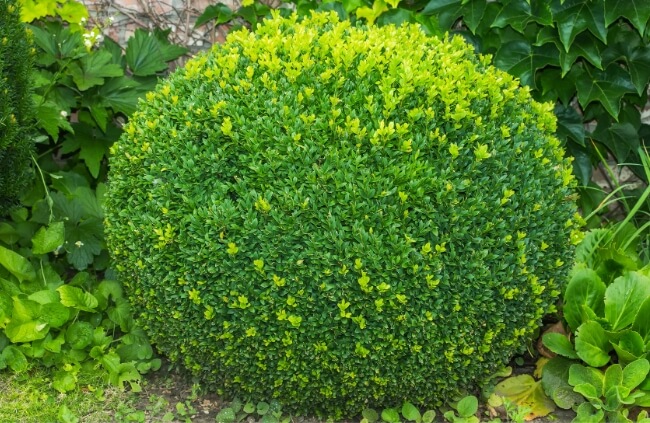
Is Buxus sempervirens fast growing?
Buxus sempervirens is not a fast-growing shrub but can grow at least one foot per year once established, typically vertically from each cut point. Regular pruning will keep on top of this easily.
How tall do Buxus sempervirens grow?
Buxus sempervirens can grow to about 9m tall if left to grow into its natural tree form, but with any tip pruning, it will rarely reach higher than 4m as the tips produce new lead branches that divide its efforts.
Do Buxus sempervirens grow well in pots?
Buxus sempervirens grows beautifully in pots, but will need regular water, either weekly or fortnightly to maintain adequate moisture levels in Australian conditions, where the containers can dry out much faster than the earth.
Can Buxus sempervirens be cut back hard?
Buxus can be cut right back to the ground and will recover, but cutting back to the same point each year is the best way to maintain a shape. If you have a very overgrown Buxus, you can cut back into the old wood to find its shape again and then cut back to that point each year.
What is the lifespan of Buxus sempervirens?
Buxus sempervirens are long-lived trees or shrubs, with a lifespan over well over a century.
Can I feed Buxus sempervirens with tomato feed?
The best thing to feed English box, if you feel it needs some extra nutrients, is a standard tomato feed. The liquid feed is packed with the essential nutrients for Buxus, and will help to quickly alter any visible signs of nutrient efficiencies like anaemic leaves.
Why have my Buxus sempervirens gone yellow and dry?
Yellow leaves on Buxus sempervirens are usually a sign of drought or the product of a heat wave. In extreme cases, they will even lose leaves. Water well if this happens, and your hedge should recover quickly.
Why has my Buxus sempervirens gone brown?
If patches or swathes of a English box hedge turn brown, or grey-brown, it is a sign of possible box blight. The affected area is unlikely to recover even if it isn’t blight, so the safest thing to do is to cut out the brown patch, and anything touching it, before burning the removed materials.
Shape Your Garden into a Classic Outdoor Retreat with Buxus sempervirens
Buxus sempervirens has many common names; English box, common box, European box and boxwood to name a few, but it’s ‘European box’ that gives us its most informative title. These plants grow in temperate climates, and their treatment is best understood by looking at traditional European gardens.
If you’re looking for formal but organic dividers between veggie beds, or a neat way to outline your property, Buxus sempervirens is an ideal choice. Obviously, it is not without its problems, as box blight is a troubling prospect, but it's still worth trying and will always look wonderful.
Published on January 21, 2024 by Maisie Blevins
Last Updated on March 4, 2024




